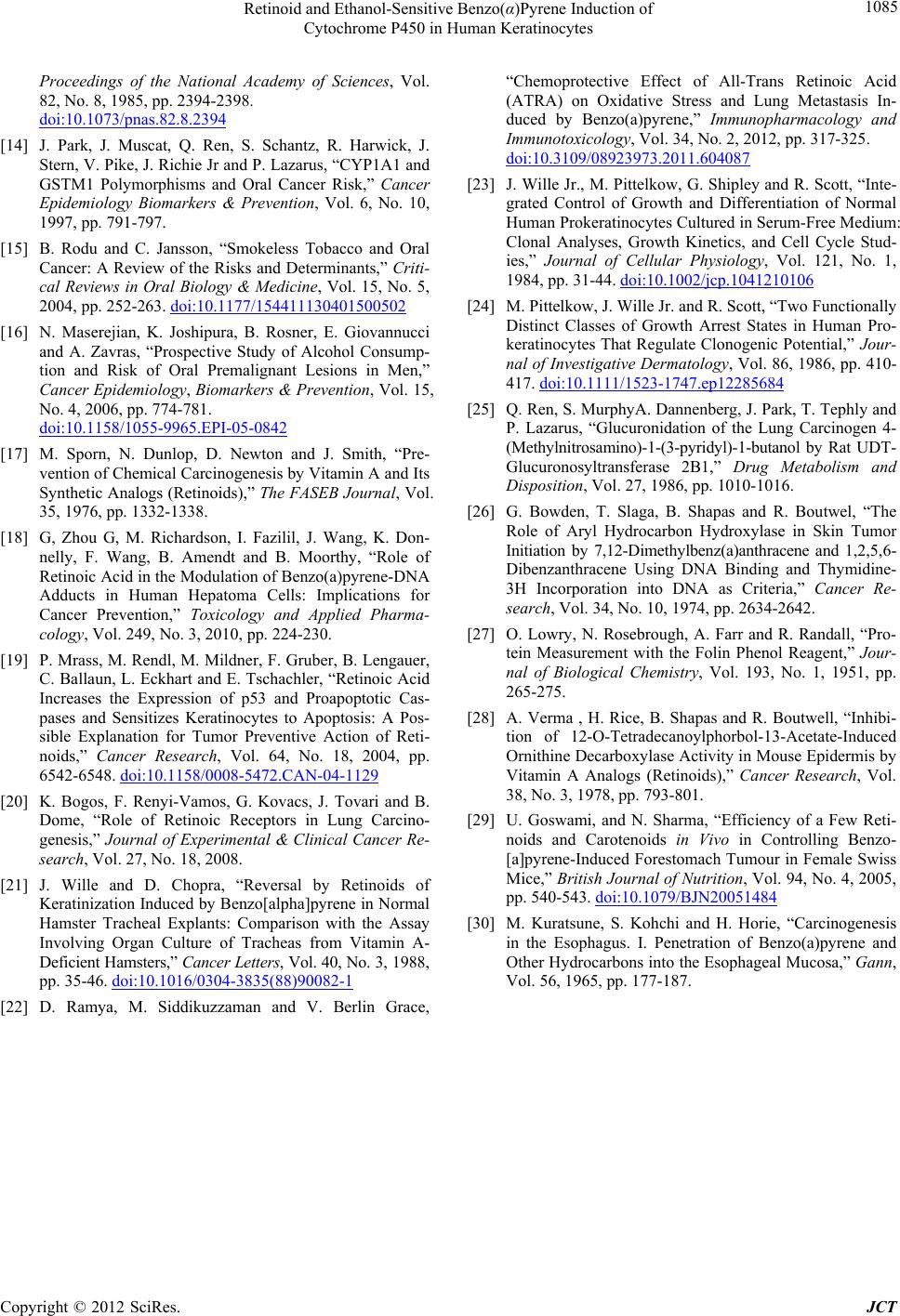
Retinoid and Ethanol-Sensitive Benzo(α)Pyrene Induction of
Cytochrome P450 in Human Keratinocytes
Copyright © 2012 SciRes. JCT
1085
Proceedings of the National Academy of Sciences, Vol.
82, No. 8, 1985, pp. 2394-2398.
doi:10.1073/pnas.82.8.2394
[14] J. Park, J. Muscat, Q. Ren, S. Schantz, R. Harwick, J.
Stern, V. Pike, J. Richie Jr and P. Lazarus, “CYP1A1 and
GSTM1 Polymorphisms and Oral Cancer Risk,” Cancer
Epidemiology Biomarkers & Prevention, Vol. 6, No. 10,
1997, pp. 791-797.
[15] B. Rodu and C. Jansson, “Smokeless Tobacco and Oral
Cancer: A Review of the Risks and Determinants,” Criti-
cal Reviews in Oral Biology & Medicine, Vol. 15, No. 5,
2004, pp. 252-263. doi:10.1177/154411130401500502
[16] N. Maserejian, K. Joshipura, B. Rosner, E. Giovannucci
and A. Zavras, “Prospective Study of Alcohol Consump-
tion and Risk of Oral Premalignant Lesions in Men,”
Cancer Epidemiology, Biomarkers & Prevention, Vol. 15,
No. 4, 2006, pp. 774-781.
doi:10.1158/1055-9965.EPI-05-0842
[17] M. Sporn, N. Dunlop, D. Newton and J. Smith, “Pre-
vention of Chemical Carcinogenesis by Vitamin A and Its
Synthetic Analogs (Retinoids),” The FASEB Journal, Vol.
35, 1976, pp. 1332-1338.
[18] G, Zhou G, M. Richardson, I. Fazilil, J. Wang, K. Don-
nelly, F. Wang, B. Amendt and B. Moorthy, “Role of
Retinoic Acid in the Modulation of Benzo(a)pyrene-DNA
Adducts in Human Hepatoma Cells: Implications for
Cancer Prevention,” Toxicology and Applied Pharma-
cology, Vol. 249, No. 3, 2010, pp. 224-230.
[19] P. Mrass, M. Rendl, M. Mildner, F. Gruber, B. Lengauer,
C. Ballaun, L. Eckhart and E. Tschachler, “Retinoic Acid
Increases the Expression of p53 and Proapoptotic Cas-
pases and Sensitizes Keratinocytes to Apoptosis: A Pos-
sible Explanation for Tumor Preventive Action of Reti-
noids,” Cancer Research, Vol. 64, No. 18, 2004, pp.
6542-6548. doi:10.1158/0008-5472.CAN-04-1129
[20] K. Bogos, F. Renyi-Vamos, G. Kovacs, J. Tovari and B.
Dome, “Role of Retinoic Receptors in Lung Carcino-
genesis,” Journal of Experimental & Clinical Cancer Re-
search, Vol. 27, No. 18, 2008.
[21] J. Wille and D. Chopra, “Reversal by Retinoids of
Keratinization Induced by Benzo[alpha]pyrene in Normal
Hamster Tracheal Explants: Comparison with the Assay
Involving Organ Culture of Tracheas from Vitamin A-
Deficient Hamsters,” Cancer Letters, Vol. 40, No. 3, 1988,
pp. 35-46. doi:10.1016/0304-3835(88)90082-1
[22] D. Ramya, M. Siddikuzzaman and V. Berlin Grace,
“Chemoprotective Effect of All-Trans Retinoic Acid
(ATRA) on Oxidative Stress and Lung Metastasis In-
duced by Benzo(a)pyrene,” Immunopharmacology and
Immunotoxicology, Vol. 34, No. 2, 2012, pp. 317-325.
doi:10.3109/08923973.2011.604087
[23] J. Wille Jr., M. Pittelkow, G. Shipley and R. Scott, “Inte-
grated Control of Growth and Differentiation of Normal
Human Prokeratinocytes Cultured in Serum-Free Medium:
Clonal Analyses, Growth Kinetics, and Cell Cycle Stud-
ies,” Journal of Cellular Physiology, Vol. 121, No. 1,
1984, pp. 31-44. doi:10.1002/jcp.1041210106
[24] M. Pittelkow, J. Wille Jr. and R. Scott, “Two Functionally
Distinct Classes of Growth Arrest States in Human Pro-
keratinocytes That Regulate Clonogenic Potential,” Jour-
nal of Investigative Dermatology, Vol. 86, 1986, pp. 410-
417. doi:10.1111/1523-1747.ep12285684
[25] Q. Ren, S. MurphyA. Dannenberg, J. Park, T. Tephly and
P. Lazarus, “Glucuronidation of the Lung Carcinogen 4-
(Methylnitrosamino)-1-(3-pyridyl)-1-butanol by Rat UDT-
Glucuronosyltransferase 2B1,” Drug Metabolism and
Disposition, Vol. 27, 1986, pp. 1010-1016.
[26] G. Bowden, T. Slaga, B. Shapas and R. Boutwel, “The
Role of Aryl Hydrocarbon Hydroxylase in Skin Tumor
Initiation by 7,12-Dimethylbenz(a)anthracene and 1,2,5,6-
Dibenzanthracene Using DNA Binding and Thymidine-
3H Incorporation into DNA as Criteria,” Cancer Re-
search, Vol. 34, No. 10, 1974, pp. 2634-2642.
[27] O. Lowry, N. Rosebrough, A. Farr and R. Randall, “Pro-
tein Measurement with the Folin Phenol Reagent,” Jour-
nal of Biological Chemistry, Vol. 193, No. 1, 1951, pp.
265-275.
[28] A. Verma , H. Rice, B. Shapas and R. Boutwell, “Inhibi-
tion of 12-O-Tetradecanoylphorbol-13-Acetate-Induced
Ornithine Decarboxylase Activity in Mouse Epidermis by
Vitamin A Analogs (Retinoids),” Cancer Research, Vol.
38, No. 3, 1978, pp. 793-801.
[29] U. Goswami, and N. Sharma, “Efficiency of a Few Reti-
noids and Carotenoids in Vivo in Controlling Benzo-
[a]pyrene-Induced Forestomach Tumour in Female Swiss
Mice,” British Journal of Nutrition, Vol. 94, No. 4, 2005,
pp. 540-543. doi:10.1079/BJN20051484
[30] M. Kuratsune, S. Kohchi and H. Horie, “Carcinogenesis
in the Esophagus. I. Penetration of Benzo(a)pyrene and
Other Hydrocarbons into the Esophageal Mucosa,” Gann,
Vol. 56, 1965, pp. 177-187.